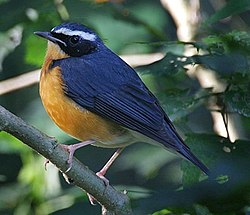| Indian blue robin | |
|---|---|
 | |
| Scientific classification | |
| Kingdom: | Animalia |
| Phylum: | Chordata |
| Class: | Aves |
| Order: | Passeriformes |
| Family: | Muscicapidae |
| Genus: | Larvivora |
| Species: | L. brunnea |
| Binomial name | |
| Larvivora brunnea | |
 | |
| breeding range overwintering range | |
| Synonyms | |
Erithacus brunneus Contents | |
The Indian blue robin (Larvivora brunnea) is a small bird found in the Indian subcontinent. Formerly considered a thrush, it is now considered one of the Old World flycatchers in the family Muscicapidae. It was earlier also called the Indian blue chat. It is migratory, breeding in the forests along the Himalayas of Nepal, India, Myanmar and Bangladesh. [1] They winter in the hill forests of the Western Ghats of India and in Sri Lanka.


